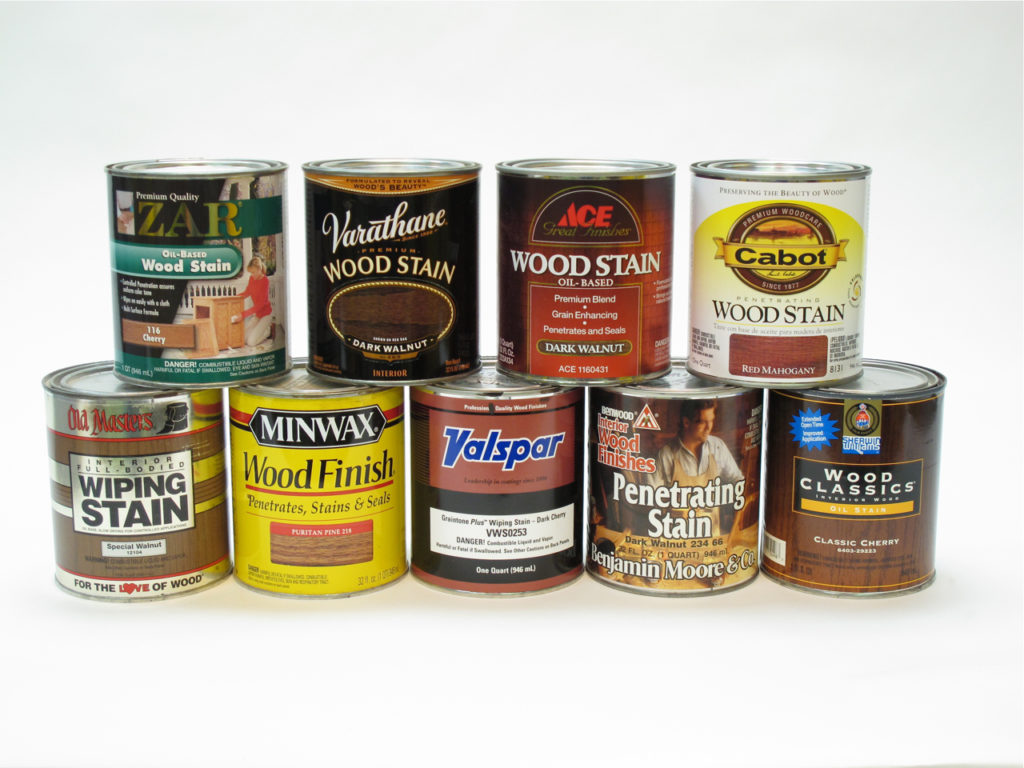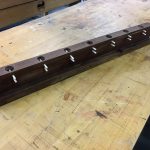We may receive a commission when you use our affiliate links. However, this does not impact our recommendations.

Notice that all of these common wood stains are labeled “stain.” Only Minwax labels its stain a “finish.”
I often come across people who are confused about the difference between a stain and a finish. They’ll use a phrase such as “I want to stain the wood,” or “would you stain the wood for me?” when what they really want is some color added to the wood and a finish applied to deepen the color and protect the wood from moisture. They’re including the finish within the word “stain,” and the two are very different.
If you’ve been doing woodworking and finishing for a while, you know the difference, and you probably don’t even notice anymore when a manufacturer labels their stain a “finish.”
Of course, I’m referring to Minwax. Something bad should happen to this company for the confusion it causes. I’ve actually heard serious woodworkers in seminars open the discussion by asking, “What’s the difference between a stain and a finish?”
In my early days of woodworking Minwax was a small player, so it didn’t make all that much difference that their stain was mislabeled (a overly nice term). But through the years Minwax has bought lots of shelf space and became arguably the dominant player in the consumer and amateur-woodworker market. During this time the company changed ownership so many times that there’s surely no one left who can explain how this mislabeling got started.
In case you’re confused about the difference between a stain and a finish, here’s an explanation.
The common stain you buy at the store contains a little colorant, usually pigment, a little binder (finish) to “glue” the colorant to the wood, and a lot of thinner. It’s very thin and easy to apply. You do this by wiping, brushing, dipping or spraying a wet coat. To get even-color results you then wipe off the excess before the stain dries.
With oil-based stains that thin with mineral spirits (paint thinner), which is often called by the more technical terms “petroleum distillate” or “aliphatic hydrocarbon” on the label just to make you think the product is something special, wiping off is easy because the stain takes a long time to dry. With water-based stains, which dry as fast as the water evaporates, you don’t have much time, so you may need to work faster, work on smaller areas at a time, or get someone else to wipe right after you apply.
The purpose of the stain is to change the color of the wood, nothing more. But a stain will lighten some as it dries. It will lose its “wet look.”
A finish is much thicker than a stain. Its purpose is to make the wet look permanent and protect the wood from moisture.
If you wet wood with any liquid, the wood becomes richer and deeper. But when the liquid dries, the wood goes back to the look it had before. A finish makes the wet look permanent because it dries in the wood. It doesn’t evaporate.
Protection is achieved by applying several coats. With most finishes, such as polyurethane, water-based finish, lacquer and shellac, the coats dry hard, so you can brush or spray them and leave the excess. With oil finishes, the coats don’t get hard so you have to wipe off the excess, or you’ll get a soft sticky result that won’t be functional. Because of the resulting thinness, these finishes don’t protect well.
To achieve a finish that looks rich and feels smooth, whether or not you apply a stain first to change the color, and whether or not you’re using a hard-drying finish for better protection, you should apply at least two coats. After the first coat dries, the surface will feel rough because the liquid has raised the grain of the wood and locked it in place. You should sand this roughness smooth with fine sandpaper, usually 220 grit or finer. There’s no need to sand more than just to make the surface feel smooth.
Then remove the dust, best with a vacuum so as not to load the air with the dust, and apply a second coat. After sanding the first coat smooth, this second coat will make the wood reach its maximum depth and richness.
Very simple and clear. So why does Minwax mislabel its stain?
– Bob Flexner
Here are some supplies and tools we find essential in our everyday work around the shop. We may receive a commission from sales referred by our links; however, we have carefully selected these products for their usefulness and quality.










I imagine they mislabel intentionally for uninformed/confused consumers that want to complete a project fast and easy. The big all caps “WOOD FINISH” leads customers to think they can get the finishing done with one can of it. A person new to woodworking/finishing is probably overwhelmed with all the selection available and that wood finish label is a sigh of relief.
Just my wild guess :/
This whole finishing thing is really confusing. An FPID act would be very welcome. Reading about it and stumbled over another term: What is Enamel Paint? How does it fit into the classification of film-building finishes (shellac, lacquer, varnish, two-part, water base)?
Oh, and the story behind Minwax goes back 110 years. A long and winding path. Change the product, keep the name.
http://www.minwax.com/about-us/minwax-story/
I often wish there was a “Finish Products Identification Act” like the The Textile Products Identification Act
15 U.S.C. § 70. Excuse the legalese, I’m just quoting.
§ 70a. Misbranding and false advertising declared unlawful
(a) The introduction, delivery for introduction, manufacture for introduction, sale, advertising, or offering for sale, in commerce, or the transportation or causing to be transported in commerce, or the importation into the United States, of any textile fiber product which is misbranded or falsely or deceptively advertised within the meaning of this subchapter or the rules and regulations promulgated thereunder, is unlawful, and shall be an unfair method of competition and an unfair and deceptive act or practice in commerce under the Federal Trade Commission Act (15 U.S.C. 41 et seq.).
…
…(c) For the purposes of this subchapter, a textile fiber product shall be considered to be falsely or deceptively advertised if any disclosure or implication of fiber content is made in any written advertisement which is used to aid, promote, or assist directly or indirectly in the sale or offering for sale of such textile …
—————–
Also, the generic (not a trademarked) name must be used. That might help the “petroleum distillate”, “stoddard solvent,” “white spirit,” or “aliphatic hydrocarbon” issue.
You can’t say “Plush Wooly Sweater” if it is made of polyester, not containing any wool.
It would eliminate things like “Tung Oil Finish,” “Teak Oil,” “Oil-Urethane Blend”, Water-based Polyurethane, etc.